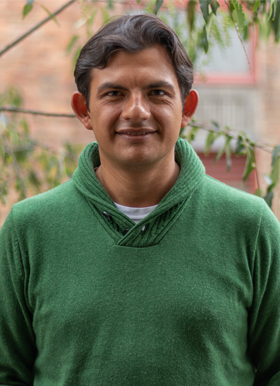
Alejandro Reyes, PhD
Voluntary Research Assistant Professor, Pathology and Immunology
Division
- Laboratory & Genomic Medicine
Additional Titles
- Associate Professor, Department of Biological Sciences, Universidad de los Andes, Bogotá, Colombia
- Group Leader Max Planck Tandem Group in Computational Biology
Education
- BS, Microbiology: Universidad de los Andes, Bogotá, Colombia (2003)
- MS, Biological Sciences: Universidad de los Andes, Bogotá, Colombia (2005)
- PhD, Computational and Systems Biology: Washington University School of Medicine, St Louis (2013)
Research Interests
During my undergraduate education as a microbiologist I came to appreciate the fascinating world of microbial communities upon learning how in any given environment of the world there are constant interactions between millions of organisms from different species with important consequences for the ecosystems they inhabit, including our own human body. For decades, Ecology and Microbiology seemed to be unrelated fields and thus the discipline of Microbial Ecology took a long time to emerge and consolidated; largely due to a lack of proper tools and technologies to explore it. However, with the development of Next Generation Sequencing (NGS) technologies, efficient algorithms for analyzing such data, and methodologies that allow the simultaneous study of all the (micro)organisms present in an environment at a given moment, in the last decade it has been possible to delve deeper into microbial interactions in which is currently known as meta-omic sciences. In my current position as Associate Professor I apply and develop genomic and computational tools and approaches for the study of different biotic communities to gain an understanding of their impact in biogeochemical cycles, agriculture, and human and animal health.
Publications
| Restrepo L, Bayot B, Arciniegas S, Bajaña L, Betancourt I, Panchana F, Reyes A. PirVP genes causing AHPND identified in a new Vibrio species (Vibrio punensis) within the commensal Orientalis clade. Scientific Reports (2018), August 30; (8): 2045-2322; https://doi.org/10.1038/s41598-018-30903-x |
| Reyes A, Alves JMP, Durham AM, Gruber A. Use of profile hidden Markov models in viral discovery: current insights. Advances in Genomics and Genetics. 2017 14 July 2017 Volume 2017:7 Pages 29-45. https://doi.org/10.2147/AGG.S136574 |
| Borbón A, Reyes A, Vives MJ, Caballero S. Captivity shapes the gut microbiota of Andean bears: insights into health surveillance. Frontiers in Microbiology. 2017. July 8:1316. https://doi.org/10.3389/fmicb.2017.01316 |
| Rodriguez-Castano G.P, Caro-Quintero A, Reyes A, Lizcano F. Advances in Gut Microbiome research, opening new strategies to cope with a Western lifestyle. Frontiers in Genetics (2017) Jan 7;224. https://doi.org/10.3389/fgene.2016.00224 |
| Reyes A, Blanton L. V., Cao S. Zhao G, Manary M, Trehan I, Smith M.I., Wang D, Virgin H.W, Rohwer F, Gordon J.I. Gut DNA viromes of Malawian twins discordant for severe acute malnutrition. PNAS (2015), Sept 22; 112(38):11941-11946. https://doi.org/10.1073/pnas.1514285112 |
| Reyes A, Wu M, Mcnulty NP, Rohwer FL, Gordon JI. Gnotobiotic mouse model of phage-bacterial host dynamics in the human gut. Proc Natl Acad Sci USA. 2013;110(50):20236-41 https://doi.org/10.1073/pnas.1319470110 |
| Reyes A, Semenkovich NP, Whiteson K, Rohwer F, Gordon JI. Going viral: next-generation sequencing applied to phage populations in the human gut. Nat Rev Microbiol. 2012;10(9):607-17. https://doi.org/10.1038/nrmicro2853 |
| Forsberg KJ, Reyes A, Wang B, Selleck EM, Sommer MO, Dantas G. The shared antibiotic resistome of soil bacteria and human pathogens. Science. 2012;337(6098):1107-11. https://doi.org/10.1126/science.1220761 |
| Reyes A, Haynes M, Hanson N, et al. Viruses in the faecal microbiota of monozygotic twins and their mothers. Nature. 2010;466(7304):334-8. https://doi.org/10.1038/nature09199 |
| Reyes A, Salazar M, Granja C. Temperature modifies gene expression in subcuticular epithelial cells of white spot syndrome virus-infected Litopenaeus vannamei. Dev Comp Immunol. 2007;31(1):23-9. https://doi.org/10.1016/j.dci.2006.05.003 |